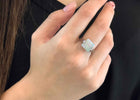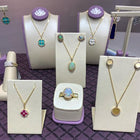The Anatomy of an Engagement Ring

The Anatomy of an Engagement Ring
The anatomy of an engagement ring is more complex than many people realize.
As you begin to shop for an engagement ring, it’s easy to find the process overwhelming. Whether you want to collect inspiration or find the perfect ring for your partner, you run into terms and lingo you might not recognize.
Often, an engagement ring seems like a simple idea. However, there are several features that go into settings. When you know how to differentiate the parts, it helps you explore your options.
Moreover, it helps you communicate your preferences to your jeweler. Houston couples often enjoy shopping for rings together, too. This helps the pair find something that works for everyone.
Still, no matter your situation, it’s a good idea to prepare. Below, we take a look at the anatomy of an engagement ring.
The Different Parts of an Engagement Ring
The Setting
When it comes to the anatomy of an engagement ring, it’s good to start with the “setting.” The setting of your ring includes everything aside from the center stone. Moreover, it refers to how we set or mount stones on the band.
The purpose of the setting is two-fold.
- Settings support the ring itself and the stone.
- It highlights the beauty and shine of the center stone.
When you know the style of your setting, you already make a major impact on the final look of your ring. Additionally, you help to determine the performance of the stones as well as the maintenance your ring requires.
In terms of style, we often break settings down into styles. Here are six of the more common setting styles.
Solitaire
This is a classic, popular choice for settings. As the name suggests, they feature a singular center stone on an all-metal band. This places all the focus on the stone.
Still, many jewelers and couples accent solitaire engagement rings with a stylized wedding band.
Three-Stone Settings
When someone decides on a three-stone setting, they often do so for the added shine and symbolic meaning. This engagement ring setting features a center stone with two smaller diamonds on each side as accents.
These three stones represent a couple’s journey through life together: their past, present, and future.
Bezel
A bezel setting offers security to your ring. This is because the outer edge of the stone boasts a layer of precious metal. The added layer holds the stone in place and offers the ring a more contemporary look.
Halo
In a halo setting, the engagement ring features a single stone at the center. Then, smaller gemstones encircle the stone. This offers a more dazzling appeal to the ring.
Often, this setting creates a larger appearance for the center diamond. When you want your ring to be a showstopper, this is a great choice.
Hidden Accent
Engagement rings with a hidden diamond accent continue to grow in popularity. Often, jewelers hide these accents in a halo under the center stone, on a gallery, or in an accented bridge. These hidden accents produce a dazzling effect as the setting sparkles from different angles.
Pavé
In a pavé setting, the ring features a band with a great deal of smaller diamonds. Set close together, they give the ring a diamond-encrusted look. Generally, this adds an extra pop through a subtle sparkle.
Center Stone
The next aspect in the anatomy of an engagement ring is the center stone. This is the largest diamond or gemstone on the ring. It sits directly in the center and is the star of the show.
As you search for the right engagement ring, this tends to be where the most consideration goes. Traditionally, people choose a round center stone. However, many jewelers offer stones in fancy shapes, ranging from oval and pair to radiant and marquis cuts.
These custom looks continue to become more and more popular.
Accent Stones
When it comes to the anatomy of an engagement ring, the accent stones highlight the center stone. Often, jewelers set them to the side of the center stone and attach them to the shoulders.
For accents, you have your choice of diamonds or other gemstones. Moreover, they come in an array of fancy shapes to offer you a unique look.
Depending on your personal preferences, these accents might fully encircle the band or span a small portion of the engagement ring.
Head
The “head” of the ring is the top of the setting. This is the part of the engagement ring that holds the center stone in place. Moreover, it includes both the prongs and the gallery.
Prongs
In the anatomy of an engagement ring, the prongs hold the center stone in place. They are the small metal tips that protrude from the setting. Generally, they come in a few shapes.
- Claw prongs with pointed ends
- V-shaped prongs
- Rounded, bead prongs
The style of the prongs tends to depend on the setting as well as the shape of the center stone. Engagement ring settings tend to have four or six prongs. However, some fancy diamond shapes require an odd number of prongs.
Gallery
The “gallery” refers to the details of the underside of the center stone. Typically, these are viewable from the side profile of the ring. The gallery is a space to feature more intricate designs, such as hidden accents.
These add to the uniqueness of the ring.
Bridge
In the anatomy of an engagement ring, the bridge rests atop the finger. It is below the head of the ring. This part of the ring increases the support for the head.
Additionally, it is another area for jewelers to add intricate details to enhance the appearance of the ring.
Shoulder
The shoulder of an engagement ring is the top sides that form the beginning of the shank. There are several options for this area.
- Twisted
- Curved
- Flat
- Other unique designs
Shank
Oftentimes, people refer to the shank as a “band.” This is the metal part of the ring the encircles the finger. The shank begins at each shoulder and tends to be all-metal.
However, there are options for the shank to feature diamond accents. This ranges from short spans to the entirety of the band. In the anatomy of an engagement ring, the shank impacts the appearance of the ring as well as how it feels on the finger.
The Sizing Area
The bottom portion of the shank is what jewelers refer to as the sizing area. This is the part that jewelers cut to ensure the ring fits properly. When we size an engagement ring, we cut this area and add or remove metal to ensure a good fit.
Exploring the Anatomy of an Engagement Ring
If you have any questions about the different parts of an engagement ring, our expert jewelers are happy to help. Moreover, we are more than happy to help you explore rings that meet your style preferences.
Visit our Houston jewelry store today or text us via the icon below. For a private appointment, reach out to our specialists to schedule a time that works for you.






